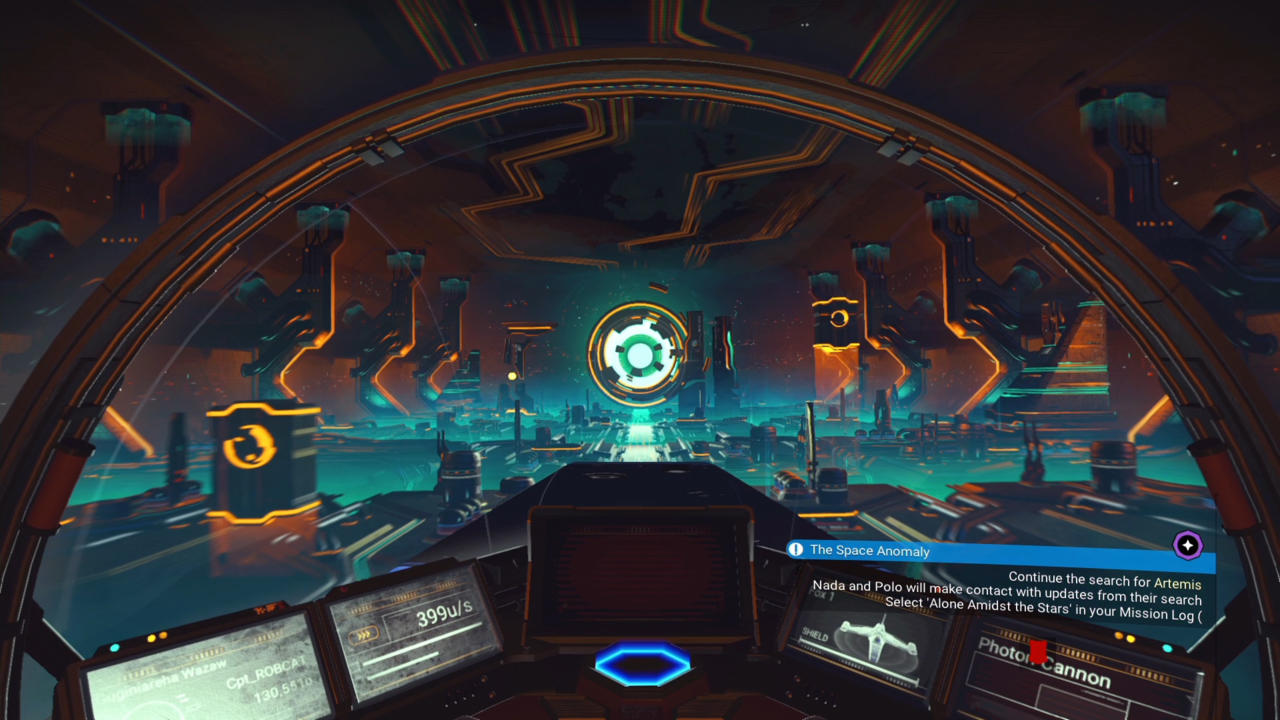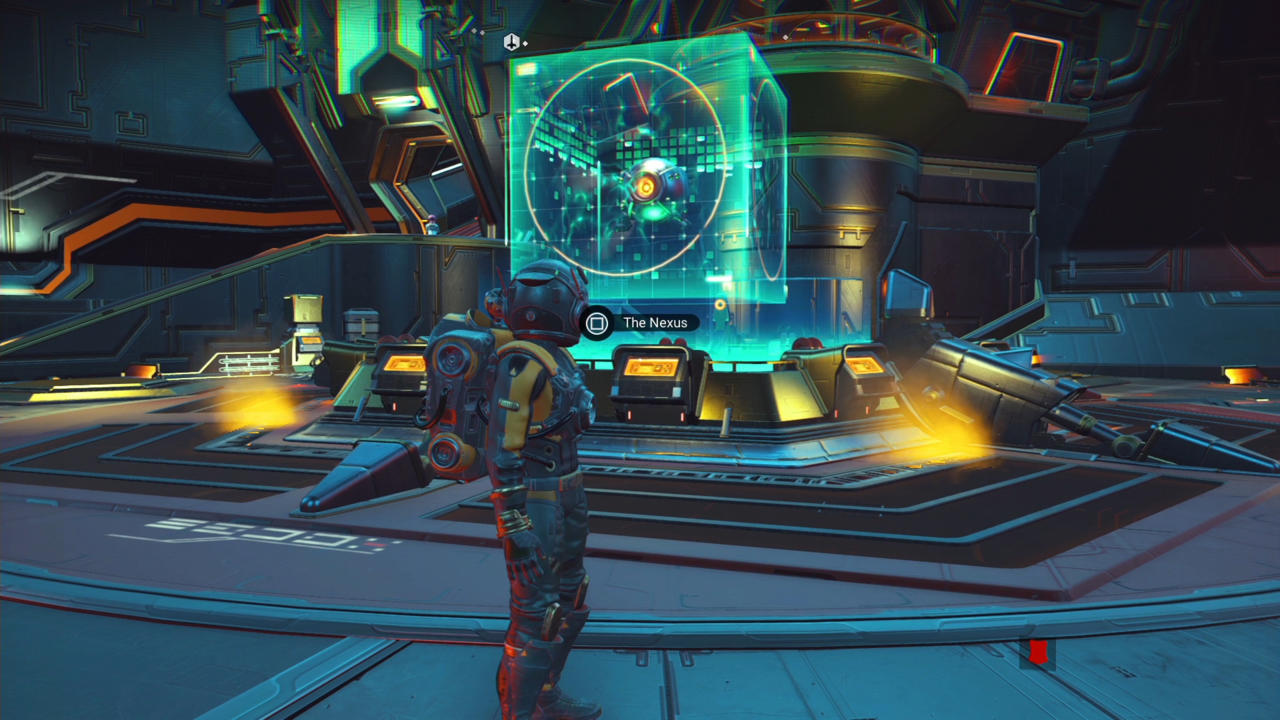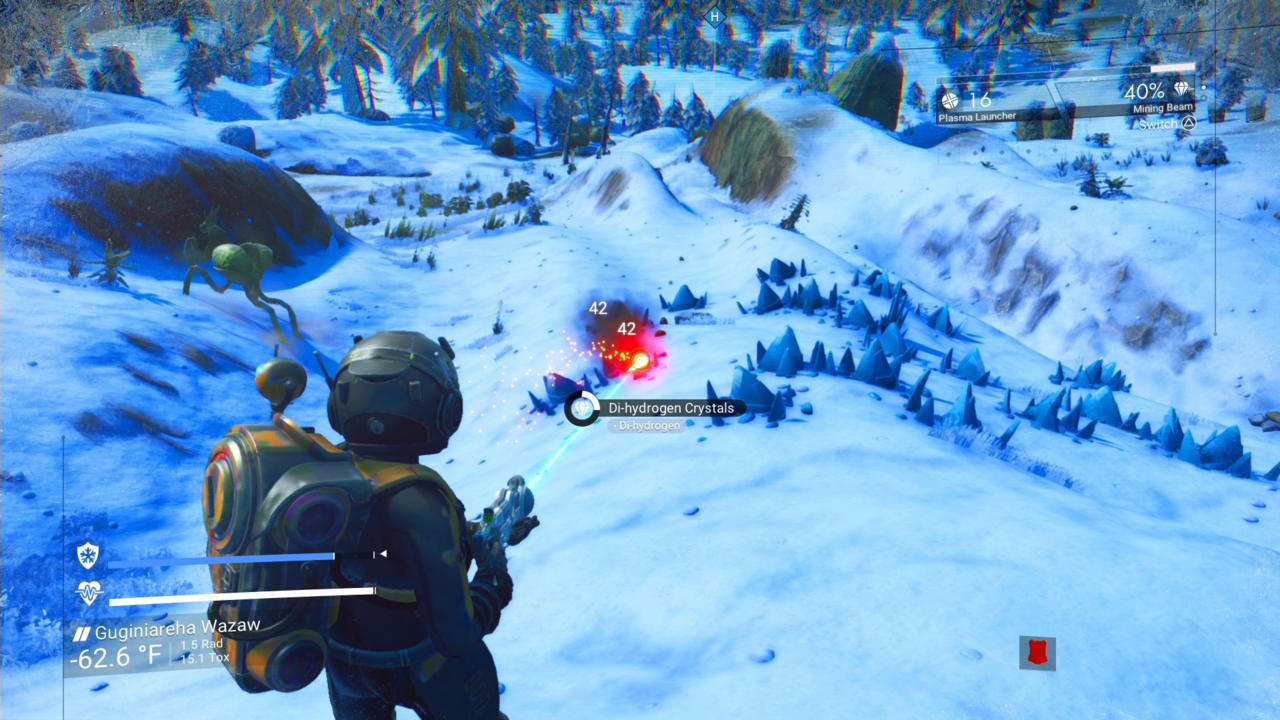Three years after release, the universe of No Man's Sky continues to evolve. With each expansion, I spend weeks as a blissful wanderer, seeing an already vast universe become more populous, more beautiful, more capable of sustaining a home for anyone who dared to voyage within it. Beyond, however, is no mere evolution and refinement. It feels like No Man's Sky approaching its final form, having shed a great deal of what was previously limiting and restrictive. But there’s one new factor specifically that makes the update live up to its name: No Man’s Sky is now a VR title. And it is utterly breathtaking.
It is breathtaking right away, waking up for the first time completely immersed in an alien world literally no one else has ever seen. Everything has a new fascination: the way the flora moves and shifts under harsh weather, the way the ground is pockmarked and windswept, the vast, unknowable vistas stretching across toxic interstellar perdition. It’s all beautiful before you even make the first flight into space.
An incredible amount of additional work has gone into making inhabiting that Exo-Suit even more of an experience. On PS4, you can play in 2D or VR with the DualShock, something that also gives you a Smooth turning option, but two PlayStation Moves are the real way to go. With the Move, your Multi-Tool is strapped to your back, ready to be whipped out more like in Blood & Truth than an ever-present floating gun like in most VR titles. The Analysis visor has you pressing the wand to the side of your head, like you’re Cyclops preparing to fire an Optic Blast. Getting in and out of your ship involves physically pulling the handles, and escaping from a hairy situation with sentinels or the local wildlife with that lightning quick motion adds an even greater layer of tension. Best of all, the menus are mapped to a little hologram in your hands that activates when you point at it. It’s a simple and intuitive implementation of such an elaborate and persistent mechanic.
Still, even with the new perspective and tools at your disposal, it should be said upfront that at its core, No Man’s Sky: Beyond is still, well, No Man’s Sky. Whether you’re in VR or not, many of the early mundanities of the game remain. You have to repair your broken ship, gather a specific resource, create fuel, drop a refiner, and so on. Beyond, however, brings varying kindnesses that welcome you to a new universe instead of prodding you into space with a stick. The UI holds your hand, telling you exactly why you’re collecting these things, what it is you’re trying to do, and exactly how to find what you need. Once you’ve found everything, having an expanded inventory and an absurd amount of space to hold items--each block can hold thousands now--means mining constantly in your travels is worthwhile. There’s always something you can use later, and you have the space to contain it. The game is much more patient and generous with the breadcrumbs that teach you how to play, guiding you into the stratosphere not only painlessly but purposefully.
That extends into the rest of the game once the tutorials stop and the training wheels are all the way off. All of the larger narrative pieces from the previous updates feel organically woven into Beyond. Dialogue and instructions from one mission from the Atlas Path may be rewritten or tweaked to reference Artemis or some new action you can take in Beyond. Direct links have been made where the next logical step in your current mission involves learning more alien language instead of just trying to get your next cell to warp to the next galaxy. The missions and their objectives have a synergy now, where lines of dialogue and specific mission objectives weave narrative strands together. It’s a bit of minor housekeeping No Man's Sky has needed for a while now. The overarching subtle tale of both exploration and acceptance in the great unknown remains, but it also has quite a bit more meaning now that it’s not your sole purpose in the universe.
When your only task was just to keep hopping from galaxy to galaxy towards the center, there was plenty to see and take in, but you couldn’t really live in the universe because you were so busy trying to survive. The Atlas Path asked some big, existential questions, sure. Artemis helped with that a great deal, giving you an Other to truly work towards understanding and fathoming at least one small mystery of the universe with. But there’s a huge difference between looking at a vast wilderness from a hypothetical distance and trying to figure out the very real challenge of laying down roots there. The latter is a much more fundamental part of Beyond’s gameplay loop. It’s the difference between Next telling you that yes, now you can build bases and here’s how, versus those bases being more of a necessity to sustainably start traversing the universe. The way menus and options are streamlined for you in Beyond make it easier to create, leave, and return to a place of solace and safety, and to depend on a planet, your base, and the resources within. It’s a much stronger experience, and the undercurrent of humanism running throughout the Atlas Path lands much harder as a result. Beyond’s biggest improvements are all in favor of fostering that relationship between players and the universe around them, and that includes its people, playable and non-playable.

No Man’s Sky has long had one of the more positive and welcoming online communities in the gaming landscape, and there was always the worry that removing the barriers between players would invite the worst elements of online play into what’s typically a place of zen. This is far from the case.
The new Anomaly, summonable to any galaxy at any time, is no longer a sparse, glorified save space, but a bustling 16-player hub of activity, full of greetings, proud ship captains, aliens who look upon you with curious eyes, and players more than happy to bring you to the worlds they call home. Just like the first spoken line of the game, so much of the Anomaly’s layout, from its menus to the way it presents the current state of the area, is about reminding you that you’re never fully alone out there. Beyond has made it so much easier to find allies to either assist in their mission or share what you have from your own inventory. Everything you pick up and mine may have a price, but the game quite often reminds you via the descriptions that those items can also be given to others. Clicking an item while on the Anomaly gives you a list of everyone in range that you might possibly hand it off to. Checking mission boards reminds you there are people who may be looking for the same thing you are, and when it’s the other way around, the request shows up in the lower left. During my time with the update, there were good Samaritans everywhere in the Anomaly, giving out extra rare items to whoever wandered into range.

That’s a rather huge and heartening factor, not just because you can now jump in and help strangers shoot things down and collect loot, but because it creates a strong sense of community in what was previously a fairly lonely adventure. The Anomaly feels like the petri dish for No Man’s Sky to develop an actual culture, a place of cooks, pilots, space frontiersmen, and traders looking for the next big score. It feels alive and connected in all the ways the game used to feel isolated and cold. And it does so without overshadowing the fundamental element of peaceful solo exploration if you so desire. That new emphasis on connection is never so obtrusive that it prevents you from performing one simple task or speaking to one specific NPC and leaving, but it also doesn’t feel arduous to connect with another human being the way it did before this update.
There's still some legwork involved, though. While joining games and having others join yours is a quick and simple matter (and much less finicky than it was in Next) players can occasionally spawn on drastically different locations on the same planet. That said, searching for stranded partners wound up being a weirdly fun adventure all its own.

A much bigger caveat is that for a new player to party up with friends, they still have to get out into space on their own, which makes sense. There's a lot of ways for someone who doesn't know what they're doing to irrevocably screw up a galaxy by accident, or waste a resource, or piss off a planet's Sentinels, or ruin your relationship with a species of animals. The tutorials do important work of not just showing you how to play the game, but respect the game. If you want to give a partner some of your resources, you can. But if an objective given by the game tells you to build something, giving them the exact item the game wants won’t clear that objective. That’s a limitation the game is all the better for keeping in place. Choosing to assist someone can’t be the same as beating the game with or for them. If you’re with someone, you’re there for the experience. That’s not all necessarily new for a multiplayer experience, but it does feel rare when the game is pushing you to connect with other people for what tend to be for more mercenary reasons.
For my part, I remained a solitary player, only choosing to put down sparing roots on the most beautiful worlds and never building more than I needed. I’m very much a city boy in real life. In No Man’s Sky, I’m a happy recluse with 40 acres and a species of chubby elephantine space mules I named Horace. I’ve been harvesting eggs and milk from the animals on the strawberry-pink and white world I’ve been calling home for the past year or so. Even as the universe got bigger, I would go to the Anomaly to trade, buy new ships, and hang out with aliens, but home remains solitary. So few of the self-sufficient agrarian aspects of my little home were even possible in previous updates. Beyond has made me feel more empowered to sustain that life, have a place to return to and maintain, and make improving it for the laid-back alien assistants who reside with me much easier to accomplish.

The larger technical problems with Beyond come down to problems with VR platforms in general. Despite the visual beauty, my time with the Oculus version was plagued with flaws and odd bugs and glitches. By comparison, the PSVR version caters to performance. Frame rate and gameplay are pristine there, but at the cost of clarity, especially when it comes to the various screen displays in-game. In addition, the PSVR’s old nemesis, the camera drift, rears its ugly head here, and the Recenter VR Camera option in the Pause menu does less to solve it than it should. As of this writing, however, there have been additional patches every few days, and more and more of these bugs vanish with each one.
These tiny frustrations utterly dissolve away in flight, however. No Man’s Sky’s most consistently powerful experience of seamless space travel nearly reduced me to tears as the upper atmosphere melted away into the silence and deep wonder of the galaxy. It’s the kind of thing I dreamt of as a kid. As part of an expanding experience and seemingly impossibly ever-larger universe, No Man’s Sky continues to deliver on the promise of being a space traveler--and VR assists in making it a more immersive experience.
The drastic improvements made to No Man’s Sky in its Beyond expansion are the new gold standard for how to gracefully cope with a game’s flaws post-release. The game laid the foundation with its release, but it took Beyond to elevate it into something magnificent. Successfully transitioning to VR is a creative victory on its own, but realizing just how full and vibrant and rewarding an experience this game has now become is almost poignant. Beyond represents the courage of convictions, a concept that has not only met the lofty expectations it set forth, but transcended them.